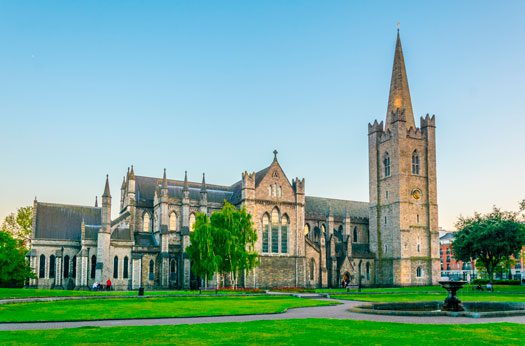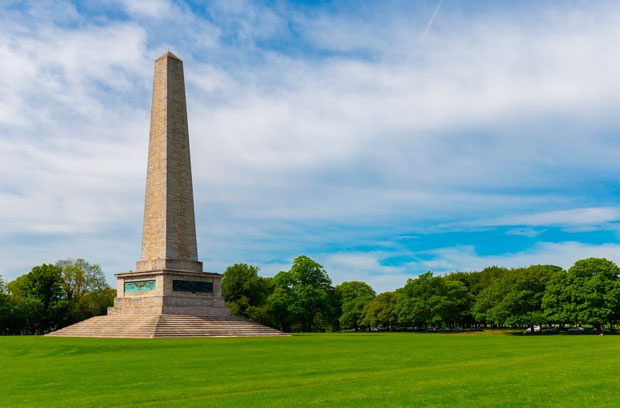BUS STOPS
Every day
(2 hour route)
First Bus Starts from stop 1 at 9:15 AM
Last Bus starts from stop 1 at 5:00 PM
POPULAR hop on hop off STOPS

Stop number 2
Dublin Castle, City Hall

Stop number 4
St. Patrick’s Cathedral, Marsh’s Library

Stop number 5
Teeling Whiskey Distillery / The Dublin Liberties Distillery

Stop number 7
Guiness Storehouse

Stop number 12
Phoenix Park, Dublin Zoo

Stop number 16
Temple Bar, The Irish Rock and Rooll Museum
City Sightseeing Bus Stops
Stop 1 - Trinity College / Irish Whiskey Museum
The first stop on our journey, you’ll learn about hisorical Trinity College, the bell tower students here are so superstitious of, and the iconic Whiskey museum. The iconic granite campanile, or bell tower, is located in Trinity College’s front square. It stands at over 100 feet tall and is a popular place for tourists to take photos. If you care to visit Trinity College, you can also visit the Book of Kells, and the Long Room, one of the most beautiful libraries in the world. At this stop we also showcase the Irish Whiskey Museum. This museum is independent of all local distilleries, meaning that one can taste a wide range of whiskeys in addition to learning about Irelands long history with the drink.
Stop 2 - Dublin Castle / City Hall
Constructed in the early thirteenth century on the site of a Viking settlement, Dublin Castle served for centuries as the headquarters of English administration in Ireland. It now belongs to the Irish government and has become an important tourist attraction. Inside the castle, you can enjoy the magnificent collection of important artistic expression and cultural production in Ireland. Visible to visitors below the castle is a section of the Castle’s medieval curtain wall with a postern gate and a set of steps that led down to the original moat.
Stop 3 - Christ Church Cathedral / Dublinia Viking Visitor Centre
CHRIST CHURCH CATHEDRAL
This Cathedral is Dublin’s oldest building still in use, in fact its almost as old as Dublin is. The church was built by the Viking King Setric and is praised for it’s beautiful architecture. The baptismal font found in the church is made up of every trype of marble found in ireland. The patron saint of Dublin, St. Laurence O’Toole’s, heart is kept here. It’s crypt is the largest crypt in Ireland and was built in the 12th-century. This magnifisant building is an important stop on our journey around the city.
DUBLIN VISITOR CENTRE
It was the heart of viking and medieval Dublin. Here you will discover more about the rich history of the city, walk exactly where the Vikings have walked and even climb an original medieval tower!
Stop 4 - St. Patrick's Catedral / The Marsh's Library
The Marsh’s Library became Ireland’s first public library in 1707. The collection here consists of European books and manuscripts from as early as the fifteenth century. Within the library there are two galleries. The first gallery was purchased by Archbishop Marsh and is currently home to 10,000 books. When visiting the library, you will see the books preserved exactly as they were three centuries ago.
In the second gallery, there is a private exhibition of Archbishop Marsh and cages that are thought to have been used in order to avoid thefts when readers asked to consult books.
Saint Patrick’s Cathedral is the National Cathedral of the Church of Ireland and is a hub of activity. The building is one of the only remaining medieval structures left in Dublin. The cathedral is one of Dublin’s most popular tourist attractions due to its rich history and unique arcitectural features.
Stop 5 - Teeling Whiskey Distillery / The Dublin Liberties Distillery
Teeling Whiskey Distillery is situated near their ancestral distillery in the centre of the historic distilling district, known as the golden triangle. This distillery is renowned for it’s unique way of producing whiskey. For example, the Teeling Distillery does not filter its whiskey before bottling, so as not to lose any facet of the product. Furthermore, strong regulation for a sustainable production can be found at the basis of the company’s social principles.
Stop 7 - Guinness Storehouse
Learn about Guinness’ founding and growth as we pass the it’s storehouse, the first skyscraper built in the British Isles. This is one of the most popular tourist locations in Dublin. The Guinness Storehouse was erected in 1904 and was the first skyscraper in the British Isles, sitting at seven-stories. This tourist hot spot is actually built around a giant pint.
Stop 8 - Pearse Lyons Whiskey Distillery
121-122, James’s Street, The Liberties, Dublin, D08 ET27
Stop 9 - Irish Museum of Modern Art and Kilmainham Gaol
Irish Museum of Modern Art
The Irish Museum of Modern Art (IMMA) is home to the National Collection of Modern and Contemporary Art. It is home to over 3,500 works of art by artists from all over the world. Exhbitions of this collection can be found at the IMMA itself or other venues in Ireland and beyond. The IMMA is also a historical site of the 17th century Royal Hospital Kilmainham.
Kilmainham Gaol
Opening in 1796, Kilmainham Gaol, the County Gaol, once held thousands of men, women and children for what were primarily minor offences. However, some of the criminals inprisoned here were involved in Ireland’s struggle for independence. The Gaol became a national monument in 1960, over 30 years after it’s closing, and was later given to the State to run. If you are interested in exploring this monument, there are often exhibits to see that change regularly.
Stop 11 - Heuston Train Station
Heuston Station is one of Dublin’s largest railway stations and allows transportation from the capital to almost all of Ireland. The station was named in tribute to Seán Heuston, one of the leaders of the 1916 Easter Rising who had worked at the station before his execution.
Stop 12 - Phoenix Park / Dublin Zoo
Phoenix Park is home to the Zoological Gardens, the residence of the President of Ireland, victorian flower gardens, and much more. There is an impressive amount of things to see and do, such as; the Dublin Zoo, multiple recreational sports, and a guided bike tour! The Phoenix Park is one of the largest public parks in any capital city in Europe. It was originally formed as a royal hunting Park in the 1660s before it was opened to the public in 1747. A large herd of fallow deer still remain to this day.
Stop 13 - Parkgate Street
Heuston Station Saint John’s Road West, Dublin
Stop 14 - National Museum / Collins Barracks
Collins Barracks, Benburb St, Stoneybatter, Dublin, D07 XKV4
Stop 15 - Smithfield Square / Jameson Distillery Bow Street
Smithfield, Dublin 7
Bow St, Smithfield, Dublin 7, D07 N9VH
Stop 16 - Temple Bar / The Irish Rock & Roll Museum
The temple bar area is located Located on the south side of the Liffey River and is probably the most popular spot in Dublin as it contains many trendy pubs and restaurants. This includes the Temple Bar Pub itself is one of the most famous pubs with a huge collection of whiskey and sandwhiches. This leads the pub to be very popular among tourists.
In the center of the temple bar is the Irish Rock n’ & Roll Museum. The perfect place for music lovers to visit, you can go behind the scenes while real music is being made here and explore the development of Irish Rock music The museum involves stories about a collection of both Irish and international artists such as The Pogues, The Frames, U2, Thin Lizzy and Sinead O’Connor.
Stop 17 - Dublin Writers Museum
18 Parnell Square N, Rotunda, Dublin, D01 T3V8
Charlemont House, Parnell Square N, Rotunda, Dublin, D01 F2X9
Stop 18 - O'Connell Street
O’Connell Street is named after Daniel O’Connell, an Irish nationalist of the 1800s, known as “the Liberator.” His statue can be seen at O’Connell Bridge. This Street is associated with the famous Easter Rising of 1916. This event ended tragically but the General Post Office, where the event happened, is now symbolic of Ireland’s independence.
The Spire here is also called the Monument to Light. It is made of steel and is considered the tallest sculpture in the world.
Stop 19 - The GPO, Abbey Theatre
The General Post Office in Dublin opened in 1818 and serves as the headquarters of An Post and the Irish Postal Service. Located in the centre of O’Connell Street, it is one of Ireland’s most famous buildings. It is the only remaining great Georgian public building in the capital, but more notably it served as the headquarters for the leaders of the Easter Rising.
The Abbey Theatre is the National Theatre of Ireland and has always been a platform for art in Dublin. Founded by W.B. Yeats and Lady Gregory in 1904, the theatre Archive is filled with over one million items dating as far back as 1894.
Stop 20 - The Irish Emigration Museum / Jeanie Johnston
The Chq Building, Custom House Quay, North Dock, Dublin 1
Custom House Quay, North Dock, Dublin 1, D01 KF84
Stop 21 - The Convention Centre Dublin
Spencer Dock, N Wall Quay, North Wall, Dublin 1, D01 T1W6
N Wall Quay, North Dock, Dublin 1
Stop 22 - Bord Gáis Energy Theatre
Grand Canal Square, Docklands, Dublin
20 Ringsend Rd, Dublin 4, D04 CF66
S Lotts Rd, Dublin 4
Stop 28 - Merrion Square / Natural History Museum / The National Gallery of Ireland
Merrion Square is one of the oldest and most well-kept Georgian areas of Dublin. Merrion Square has also been home to many famous names in history, including Daniel O’Connell and Oscar Wilde. This area is characterized by a large among of museums. National museums such as the National Gallery and the National Museum of Natural History are free to visit.
The Irish National Gallery was officially opened to the public in 1864 and with few loaner works exhibited. Now the collection has more than 10,000 artworks, including European and Irish oil paintings, drawings, prints, and sculptures.
The Irish National Museum of Natural History, or the Dead Zoo, is one of the oldest museums in Ireland. The decor hasn’t changed much changed since the Victorian era. The museum contains 2 million scientific species. The collection is divided into sub-groups: the zoological, botany, and geological collections.
Stop 29 - Mansion House / St. Ann's Church
Mansion house has been the residence of the Mayor of Dublin since 1715 and is the oldest Mayoral residence in Ireland. The Round Room was built to recieve King George IV and the iron portico located above the main entrance was built in preparation for the visit of Queen Victoria.
St. Ann’s Church was founded in 1707 and was designed with a Georgian interior and a Baroque exterior. The structure’s stain glass windows were added later to memorialize the world wars. In addition to being a religious place, cultural events also take place in the church.
Stop 30 - St. Stephen's Green / The Little Museum of Dublin, MoLI
ST STEPHEN’S GREEN.
St Stephen’s Green is a public park containing a large number of statues and sculptural monuments. The 9-hectares-park is home to a variety of bird and plant species. complete with a playground and a small lake, St Stephen’s Green makes a great peaceful reprive if you need a break from the busy city.
MOLI (MUSEUM OF LITERATURE).
The Museum of Literature came about recently from a partnership between the University College of Dublin and the National Library of Ireland. Here you can find immersive exhibitions about renowned Irish writers from the past and the present, explore the historic Newman house and it’s beautiful gardens. If you’re hungry, visit the cafe and try traditional irish cuisine!
Stop 31 - Dawson Street
Dawson street runs from Trinity College to St. Stephen Green, and on this street you can visit St Ann’s Church and see the Mansion House from outside. Perfect for tourists, this modern street offers many pubs, restaurants, shops, bars and book stores. The street is named after Joshua Dawson, who bought what appeared to be a fruitless area in 1705 and decided to renovate it. As early as 1706, Dawson had finished the plans for Dawson Street, Anne Street and Duke Street, now known as Anne Lane and Duke Lane. Now it’s your turn to discover the city we’ve just introduced you to!

